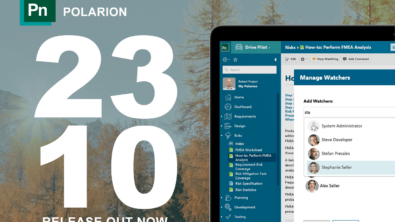Polarion ALM 19.3 – What’s New and Noteworthy
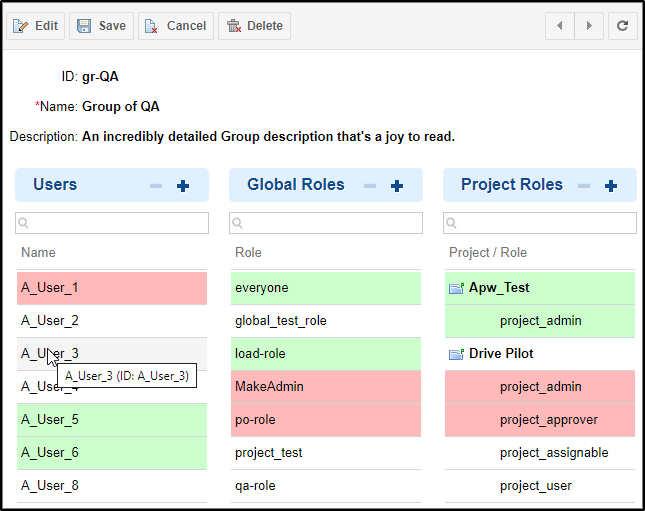
The last service release of Polarion ALM 19 is now available for download.
This release delivers User Groups management that greatly simplifies permissions management on the enterprise scale. It also adds a new Polarion LiveDoc Document feature. Users can now reuse the content of multiple LiveDocs at once, either in a new LiveDoc created during the reuse operation, or appended to an existing Document.
We also concentrated on improvements and enhancements to existing functionality, based on feedback from our customers who use our solutions every day, as well as ongoing quality improvements. Significant enhancements were done to the following:
- Usability – making the life of an end-user easier by addressing popular usability enhancements
- Query Limiting – reducing the impact of the single-user operation on system performance
- Security enhancement – two-factor authentication with Jira
Let’s have a detailed look into what’s new and noteworthy.
User groups management
Simple and efficient management of access rights and permissions
User Groups is a feature that saves time and minimizes manual work for all administrators, but especially for enterprise customers with a considerably high number of users.
An early version of the User Groups management was introduced with Polarion 19.1. This new release delivers a full-blown administration page for the User Groups.
Administrators can create Groups with complex role configurations, then easily assign a large number of users to them. Users can be members of multiple Groups simultaneously, so administrators can temporarily elevate a user’s credentials by adding them to, for example, a Project-Admin Group. When the task is done that required elevated credentials, the user can quickly be removed and reverted to their previous access level.

To mention some other User Group traits: Multi-selection works in all the lists on the Groups page, the SVN Access file is automatically synchronized every time a Group is changed, and there is a High Contrast View mode for the visually impaired.
Reuse and combine LiveDoc documents
Reuse multiple LiveDocs into a single target document
There are cases when a customer needs to produce project documentation that is partially or completely composed out of standard sub-specifications. With the new LiveDoc reuse with combine and append options, this use case is now much easier.
Users can select multiple LiveDoc documents and reuse their entire content to create a new LiveDoc, or append them to an existing LiveDoc. This new functionality can be triggered on the Index page of any Space. Users define the order of the combined LiveDocs based on the order that they are selected, but they can also adjust it via drag and drop in the new Combine Documents dialog box.

Append multiple LiveDocs to an existing document
For an Append operation, the selected Documents appear at the end of a specified existing Document in the order they’re selected but more can be added (and their order also tweaked) in the Append Documents dialog box.
Users can select any Document from the repository for Combine/Append, either as the “source” Document (for Combine) or the “target” Document (for Append). When Documents are combined to create a new Document, the target Document can be created in any Space in any Polarion project. (Provided that the user has the necessary permissions.)
The original Source Documents remain untouched. All their objects (Work Items including Headings, attachments, text, etc.) are copied to the target Document. The target Document maintains link consistency between copies of Work Items, and a link is created between the copy and its original.
Selecting historical LiveDoc version
Source Documents can be selected from a historical revision or Baseline:
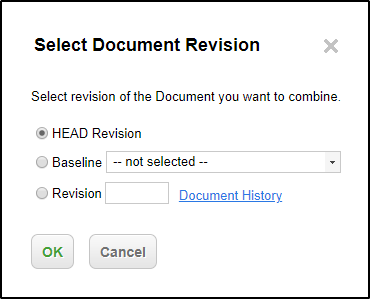
Usability enhancements
Multi-selection in the configuration of table columns
Following the improvements of the Live Report configuration in Polarion 19.2, the same user experience has been implemented for the Work Item table configuration dialog. Users can now easily select columns via CTRL+click and SHIFT+click and add them all at once with a single click.
Additionally, the cursor now starts in the Available Columns filter when the dialog is opened, so users can start filtering the columns right away. Finally, you can now change the order of multiple columns at once in the Columns Shown list.

Editor for additional fields in the Work Item Properties sidebar
In Polarion 19.2, the Work Item Properties sidebar in the Document editor displayed additional Hyperlinks and Linked Revisions fields. With 19.3 you can now edit these fields right within the sidebar.

Export manual Work Item selection from a table
Work Item table export options have also been enhanced. Users can now choose to only export the Work Items that they manually select from the table. (You no longer need to perform an additional query to limit the query result to the few items you are really interested in.) Now you can simply select the few Work Items you are interested in and choose the “Only selected” option in the export dialog.

Display changes in string fields as a diff
The readability of changes was also improved. Now single-line changes like titles and string custom fields show the changes as highlighted when viewed in the Work Item’s history and other artifacts.
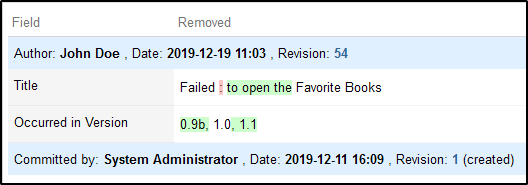
New XML editor in administration
Several XML administration pages feature a new editor with improved syntax highlighting, better validation and full-screen edit mode. The rest of the XML administration pages will be updated in the next Polarion 20 R1 release.
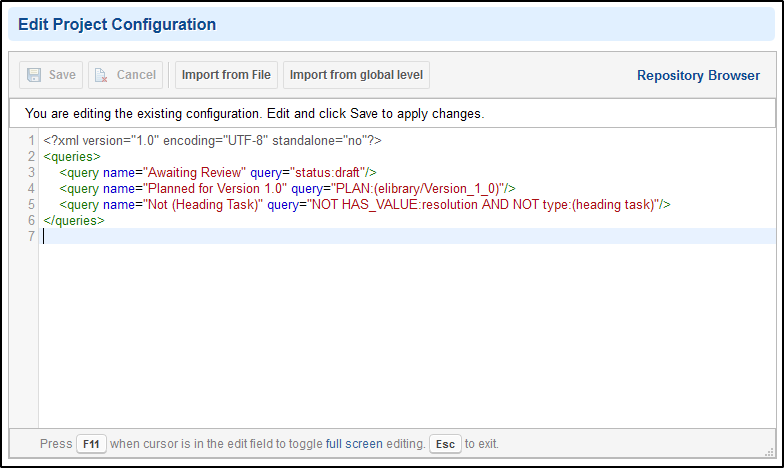
General Enhancements
Form extensions with active Javascript content
Custom form extensions that can add new sections into the Work Item form can be even more interactive because they can now leverage Javascript scripts. This applies to both the custom form extensions implemented in Java as well as the extensions based on the popular Velocity Work Item Form Extension.
History view for a baseline
Document baselines provide a history view that allows users to see changes of a baseline Name and Description.
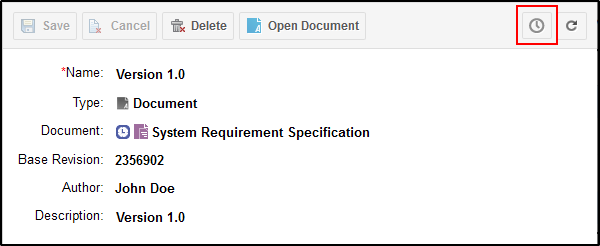
Download My Polarion page as a page archive
In order to simplify the setting up a common template for the My Polarion user dashboard, the My Polarion page can now be downloaded as a page archive. With a page archive, you can then easily set up a new Live Report with the same content that will serve as the template for all users.
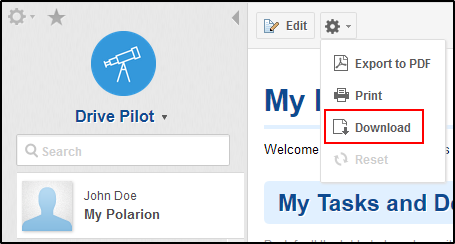
Control chart improvements
The new control chart widget introduced in Polarion 19.2 has been further extended with additional functionality:
- Clicking on a chart point opens the Work Item’s details in a new browser tab.
- Weekend and holiday definitions are loaded from the Polarion calendar to manage them centrally.
Jira connector enhancements
Two-factor authentication for Jira synchronizer via mutual TLS
In order to strengthen the security of synchronization between Polarion and Jira, the Jira connector can be optionally configured to require additional authentication via TLS certificates in addition to the usual service user credentials or token. This improvement ensures that servers are always connected to trusted counterparts and the possible compromising of credentials does not allow for unauthorized data access.
Support mandatory permissions query parameter in Jira REST API
We also added support for the now mandatory permissions query parameter for the mypermissions resource in Jira’s REST API. For more details, see the change notice for Jira.
New OS and 3rd party components support
Added support for new Linux operating systems
This new release can also be installed on the following additional, recently released Linux distributions:
- Debian 10
- Red Hat Enterprise Linux / CentOS 8
Note that Debian 10 contains a problematic version of Subversion 1.10.4 in its repositories, which suffers from issue SVN-4802 – Allow empty groups in AuthZ files. To remediate the problem, either install a newer version from a third-party that does not suffer from this problem (i.e. 1.10.6 or newer) or contact our GTAC to get a workaround for this issue.
Updated bundled PostgreSQL database
The PostgreSQL database binaries bundled with the Windows installer have been upgraded to version 11.4, so PostgreSQL version 11 is now supported.
Supported browsers information
Information on currently supported browsers and browser versions is now provided in the System Requirements chapters of the installation guides for Linux and Windows, and in online Help. All are published on Siemens Doc Center.
Performance and scalability
Reducing the impact of big queries
Query limits for Lucene and SQL search
Our experience when working with enterprise customers shows that users love Polarion reporting capabilities. However, in some cases, end-users may create inefficient reports or customizations that can stress the system heavily by fetching millions of objects and allocating a lot of memory.
In order to limit the impact of a single user on the overall Polarion application node, query limits have been introduced. There are two limits in place both for Lucene and SQL queries.
- Soft limit – if a query result exceeds 20.000 objects a warning is logged so that administrators can detect problematic reports, customizations, or use cases and take preventive actions.
- Hard limit – if the query result exceeds 100.000 objects a user-friendly exception is thrown and the execution is stopped.
This lets us notify users of their problematic behavior and lets them adjust the query or report. One user can hardly work with hundreds of thousands of objects and in many cases, the reports can be implemented in a better way, e.g. by using an SQL query with joins instead of iterating in cycles of huge results of Lucene queries.
Both limits are configurable, so they can be adjusted to fit the specific needs of different customers.
Reduced impact of huge queries on system resources
Another improvement in this regard then ensures than even a very big query has a limited impact on the system and does not allocate too much memory to the Java heap. With this improvement objects returned by query can be collected by the Java garbage collector (even during the report execution), so the system can free up additional memory if needed.
Other performance improvements
Asynchronous loading of form extensions
Polarion is by definition a tool that is providing visibility into your development process. This data may be even coming from external tools and services, e.g. the recently introduced traceability of Gitlab merge requests on the Work Item form.
Occasionally the external service may be slow or not responsive. Previously such a situation slowed down the displaying of the whole Work Item form. In Polarion 19.3, the form extensions are now displayed independently on the Work Item data, so a Work Item’s details are always displayed quickly and only the form section that’s delayed shows a progress indicator.
Configurable limit for items in visual query elements
When one assignee field per Work Item is not enough, customers tend to configure additional custom fields listing Users. With enterprise users, the list of Users can be very long and contain tens of thousands of items.
The Visual Query Builder tool was improved to support searching for fields like this, with possibly thousands of enumerations. By default, now only 100 items are displayed in the Query Builder, while still letting the user filter among all the possible values. The limit can be tweaked to fit specific customer needs.
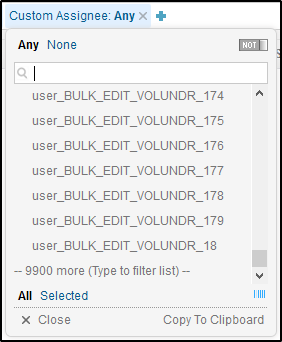
Faster loading of Traceability Matrix view
Loading of Work Items in the Traceability Matrix view has been optimized so that it only loads essential data for this view. Depending on the Work Item form configuration, this improvement can speed up the rendering of the view by more than 90%.
Improved connection pooling for PostgreSQL database
With the update of the PostgreSQL version, our teams also improved the connection pooling for the PostgreSQL database, which is not only more robust but performs better. The improvement especially affects the rendering of Plan reports, where our performance tests show that the rendering of Plan widgets was improved from 33 to 50%.
Improved scalability of login with “remember me” in a cluster
Specific cluster deployments showed that login with “remember me” can be slow if the shared storage server is not performant enough. The handling of “remember me” was moved from the shared storage server to the coordinator service to improve login scalability.
Notable issue fixes
The integrations team fixed an issue where Polarion required elevated permissions on the TFS side for synchronized from Polarion. For a listing of all fixed issues in the release, see the Resolved Issues file.
Last but not least
New release cycle coming in 2020
In case you’ve not yet heard, this is the last release of the quarterly release cycle we have followed for quite some time. We’ll be moving to a new product release schedule of 2 major releases per year and more frequent hotfix releases, as requested by many of you. For more details, check out this Software Field Bulletin.
Update Information
Version 19.3 is an update for all Polarion ALM products. It is free to all customers with a current maintenance subscription. You can download the update distribution at: https://polarion.plm.automation.siemens.com/downloads/update. For details, see the bundled HOW_TO_INSTALL_THIS_UPDATE.txt in the update distribution package or available on Siemens Doc Center.
Evaluation
If you would like to evaluate this release before updating your production installation, simply visit https://polarion.plm.automation.siemens.com/downloads, download the product of your choice, install it and use the built-in 30-day evaluation license.
If you have any questions or comments, please don’t hesitate to contact me or your Polarion technical support contact. On behalf of our entire team, thank you for using Polarion ALM.
Regards,
Radek Krotil,
Polarion ALM Product Management
